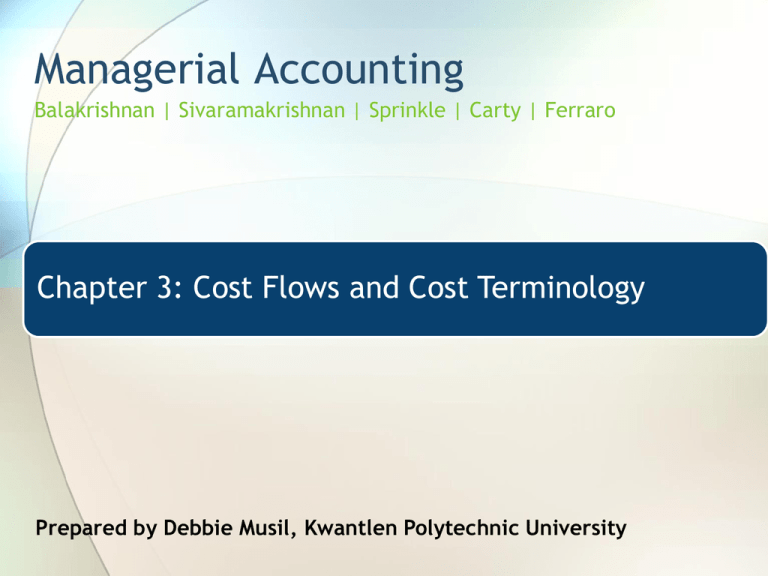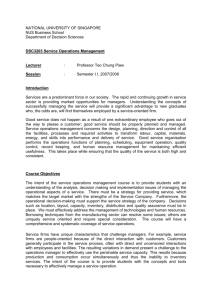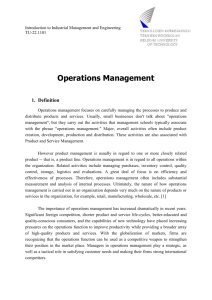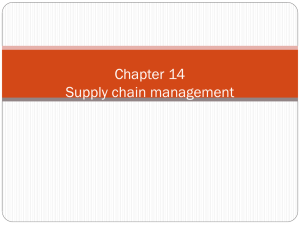
Managerial Accounting
Balakrishnan | Sivaramakrishnan | Sprinkle | Carty | Ferraro
Chapter 3: Cost Flows and Cost Terminology
Prepared by Debbie Musil, Kwantlen Polytechnic University
Types of Organizations
• Three major types
− Service
− Merchandising
− Manufacturing
• Differ in
− Nature of product
− Pattern of cost flows
− Magnitude of various costs
LO 1: Distinguish product costs from period costs.
Financial Reporting
• All three types of firms
− Produce financial reports that conform to
GAAP
− Distinguish between product costs and
period costs
• Have financial reports that are of limited
use for internal decisions
LO 1: Distinguish product costs from period costs.
Product and Period Costs
• Product costs
− Related to getting a product or service ready for
sale
− Appear “above the line” for gross margin (revenues
less product costs)
− Can be inventoried (“inventoriable costs”)
• Period costs
− Costs that are not product costs. Related to
marketing and administration
− Appear “below the line” for gross margin
− Expensed in the period they are incurred.
− Do not flow through inventory accounts
LO 1: Distinguish product costs from period costs.
A Traditional Income Statement
Period Costs
Product Costs
LO 1: Distinguish product costs from period costs.
Usefulness for Internal
Decisions
• The statement only considers expenses
− Cost versus expense
• An expense is a cost recognized in the income
statement
• The gross margin income statement
mingles
− Controllable & non controllable costs
− Variable and fixed costs
− Direct and indirect costs
LO 1: Distinguish product costs from period costs.
Service Firms
• Products are not tangible or storable
− Hotels, restaurants, consulting, airlines,
gyms, universities, museums,…
• Generally, there is no inventory of their
final product
− Exceptions exist
• We can inventory costs of software projects that
go across accounting periods
LO 2: Understand the flow of costs in service firms.
Flow of Costs: Service Settings
LO 2: Understand the flow of costs in service firms.
Merchandising Firms
• Examples include The Bay, Sears,
Sobeys, Staples,…
• These firms
− Sell substantively the same product they
purchase.
− Carry inventory to make goods available in
the quantities, varieties and delivery
schedules demanded by customers.
LO 3: Discuss how inventories affect the flow of costs in merchandising firms.
Inventory Equation
• Need to flow costs via inventory account
− Cost of goods purchased is different from cost
of goods sold
• We can capture flow as:
Cost of beginning inventory
+ Cost of goods purchased during the period
– Cost of ending inventory
= Cost of goods sold (COGS) during the period
• Make inventory cost flow assumption
− First-in-first-out (FIFO)
− Last-in-first-out (LIFO)
LO 3: Discuss how inventories affect the flow of costs in merchandising firms.
Solution
Cost of beginning inventory
+ Cost of goods purchased +
- Cost of ending inventory
= Cost of goods sold
=
$3,450,200
24,795,740
3,745,600
$24,500,340
Flow of Costs in Merchandising
LO 3: Discuss how inventories affect the flow of costs in merchandising firms.
Manufacturing Firms
• Use labour and equipment to transform
raw materials into finished goods
− Have work-in-process
− Need inventory accounts for all three kinds
of stages in the production process
• Much variation in
− Nature of production process
− Relative amounts of different costs
LO 4: Explain the cost terminology and the flow of costs in manufacturing firms.
Cost Terms in Manufacturing
LO 4: Explain the cost terminology and the flow of costs in manufacturing firms.
Names for Groups of Costs
LO 4: Explain the cost terminology and the flow of costs in manufacturing firms.
Cost Terms in Manufacturing
Prime
Costs
Conversion
Costs
LO 4: Explain the cost terminology and the flow of costs in manufacturing firms.
Physical and Cost Flows in Manufacturing
LO 4: Explain the cost terminology and the flow of costs in manufacturing firms.
Example: Cost Flow in Manufacturing
LO 4: Explain the cost terminology and the flow of costs in manufacturing firms.
To verify the amounts specified above, THREE
calculations need to be made:
Calculation
1
Procedure
Result
Calculate Raw Materials Used
Beginning materials inventory
+ Purchases
- Ending materials inventory
= Raw materials used
2
Calculate Cost of Goods Manufactured
+
+
+
=
3
$240,000
+ 1,200,000
320,000
= $1,120,000
Beginning WIP inventory
Materials used
Labour cost
Manufacturing overhead
Ending WIP inventory
Cost of goods manufactured
+
+
+
=
$50,000
1,120,000
845,000
760,500
100,000
2,675,500
Calculate Cost of Goods Sold
Beginning FG inventory
+ COGM
- Ending FG inventory
= Cost of goods sold
$375,000
+ 2,675,500
294,500
= $2,756,000
Check It! Exercise #2 Solution
Cost Allocations & Cost Flows
• Overhead costs are not traceable to
specific products
− But they are part of product cost for
individual products
• Problem: How to divide total overhead to
pieces that belong to individual products.
• Solution: Perform a cost allocation
− A procedure to allocate common costs
LO 5: Allocate overhead costs to products.
Mechanics of Cost Allocations
• Each allocation has four elements
− Cost Pool
− Cost Object
− Cost Driver (Allocation Basis)
− Allocation (Denominator) Volume
• Each allocation has two steps
− Calculate allocation rate
• Rate = Cost in pool Denominator volume
− Allocate cost to cost object
• Allocated amount = # of driver units in object x
rate
LO 5: Allocate overhead costs to products.
LO 5: Allocate overhead costs to products.
Cost Allocations: Properties
• The percent of cost allocated to a cost
object is the percent of cost driver units
in the cost object
− The Smith and Jones family each contributes
50% of the cost driver units (families). Thus,
each family gets 50% of the cost allocated to
it
− Smith family has 60% of the cost driver units
(in persons). Thus, Smith family gets 60% of
the cost allocated to it
LO 5: Allocate overhead costs to products.
To verify the amounts specified above, the
allocation rate and volume calculations need to be
made.
Calculate Allocation Volume and Rate
Allocation Volume
15,000 5-ton hooks x 25 labour hours per hook
+ 10,000 10-ton hooks x 42.50 labour hours per hook
= Total labour cost
375,000 labour hours
425,000 labour hours
800,000
Allocation rate
$16,000,000 in overhead costs/800,000 labour hours = $20 per labour hour
Calculate Amount Allocated to 5-tonne Hooks
Allocation rate
Cost driver units
$20 per labour hour x 375,000 labour hours =
$7,500,000
Calculate Amount Allocated to 10-tonne Hooks
Allocation rate
Cost driver units
$20 per labuor hour x 425,000 labour hours =
$8,500,000
Check It! Exercise #3 Solution
Allocated Costs & Decisions
• Allocations make it appear as if the
allocated cost is variable in the number
of driver units
− Cost allocated is variable in # of persons
• But, the cost is fixed in the short run
− Might not be controllable
• Mixing the two can lead to errors
LO 5: Allocate overhead costs to products.
Income Statement Example
LO 5: Allocate overhead costs to products.
Decision
• Suppose we sell one more unit for $23.
What is change in profit?
• $0? (After all, cost = $23 per unit)
− This answer is likely incorrect
− Assumes that ALL costs change (are
controllable)
− This assumption is probably not true
LO 5: Allocate overhead costs to products.
Focus on Controllable Costs
LO 5: Allocate overhead costs to products.
Revised Decision
• Variable costs are only:
− $17.50 (=$6 + 8 + $2 +1.50)
• Only these costs are controllable for
decision to make one more unit
• Profit increase
− $25 - $17.50 = $7.50!
LO 5: Allocate overhead costs to products.
Problem 3.30
Cost flows in a service firm (LO2).
The following data pertain to Skogg Consulting. Skogg provides
advice on structural engineering for large projects such as stadiums
and bridges. Clients seek Skogg out because it has extensive
contacts and can find the person who is “right” for the job. This is
not a trivial task, as often fewer than 10 people worldwide might
have the required expertise. Skogg bills clients at the rate of $350
per hour plus actual expenses for travel and accommodation. The
firm draws consultants from a roster it maintains, and it pays the
consultant $300 per hour. The balance of $50 goes toward
administrative support. The firm expects to accumulate 9,000
consulting hours for the year and projects a profit before taxes of
$230,000.
Required:
Complete an income statement to determine (a) the firm’s cost to provide
service and (b) its marketing and administration costs.
Problem 3.30 (Concluded)
Complete an income statement to determine (a) the firm’s cost to
provide service and (b) its marketing and administration costs.
The following is the gross margin statement for Skogg Consulting.
Revenues
Cost of delivering service
Gross margin
Marketing & administration
Profit before taxes
9,000 hours × $350/hour
9,000 hours × $300/hour
Plug figure
Given
We can readily obtain the answers by noting that
revenue – cost of services = gross margin and
gross margin – marketing and administration
costs = profit before taxes. Notice that we ignored
the reimbursement of actual costs in this statement. If
we included the amounts, it would increase revenue
and costs by identical amounts.
$3,150,000
2,700,000
$450,000
220,000
$230,000
Copyright
Copyright © 2011 John Wiley & Sons Canada, Ltd. All rights reserved.
Reproduction or translation of this work beyond that permitted by
Access Copyright (the Canadian copyright licensing agency) is unlawful.
Requests for further information should be addressed to the
Permissions Department, John Wiley & Sons Canada, Ltd. The purchaser
may make back-up copies for his or her own use only and not for
distribution or resale. The author and the publisher assume no
responsibility for errors, omissions, or damages caused by the use of
these files or programs or from the use of the information contained
herein.






